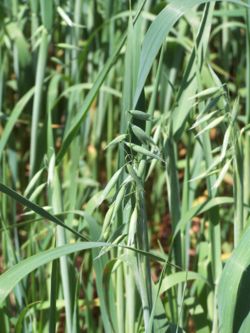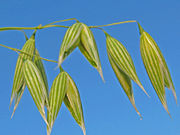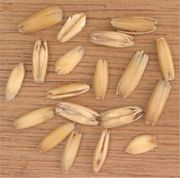Oat
2008/9 Schools Wikipedia Selection. Related subjects: Plants
- Oats redirects here. It may mean either the common cereal oat discussed here, or any cultivated or wild species of the genus Avena.
| Oat | ||||||||||||||
|---|---|---|---|---|---|---|---|---|---|---|---|---|---|---|
 Oat plants with inflorescences
|
||||||||||||||
| Scientific classification | ||||||||||||||
|
||||||||||||||
| Binomial name | ||||||||||||||
| Avena sativa L. (1753) |
The common oat plant (Avena sativa) is a species of cereal grain grown for its seed, which is known by the same name (usually in the plural, unlike other grains). While oats are suitable for human consumption as oatmeal and rolled oats, one of the most common uses is as livestock feed. Oats make up a large part of the diet of horses and are regularly fed to cattle as well. Oats are also used in some brands of dog and chicken feed.
Origin
The wild ancestor of Avena sativa and the closely-related minor crop, A. byzantina, is the hexaploid wild oat A. sterilis. Genetic evidence shows that the ancestral forms of A. sterilis grow in the Fertile Crescent of the Near East. Domesticated oats appear relatively late, and far from the Near East, in Bronze Age Europe. Oats, like rye, are usually considered a secondary crop, i.e. derived from a weed of the primary cereal domesticates wheat and barley. As these cereals spread westwards into cooler, wetter areas, this may have favoured the oat weed component, leading to its eventual domestication.
Cultivation
| Top Oats Producers in 2005 |
|
| (million metric tons) | |
| 5.1 | |
| 3.3 | |
| 1.7 | |
| 1.3 | |
| 1.2 | |
| 1.1 | |
| 1.0 | |
| 0.8 | |
| 0.8 | |
| 0.8 | |
| World Total | 24.6 |
| Source: UN Food & Agriculture Organisation (FAO) |
|
Oats are grown throughout the temperate zones. They have a lower summer heat requirement and greater tolerance of rain than other cereals like wheat, rye or barley, so are particularly important in areas with cool, wet summers such as Northwest Europe, even being grown successfully in Iceland. Oats are an annual plant, and can be planted either in autumn (for late summer harvest) or in the spring (for early autumn harvest).
Historical attitudes towards oats vary. Oat bread was first manufactured in England, where the first oat bread factory was established in 1899. In Scotland they were, and still are, held in high esteem, as a mainstay of the national diet. A traditional saying in England is that "oats are only fit to be fed to horses and Scotsmen", to which the Scottish riposte is "and England has the finest horses, and Scotland the finest men". Samuel Johnson notoriously defined oats in his Dictionary as "a grain, which in England is generally given to horses, but in Scotland supports the people". Given the centrality of oats in traditional Scottish cuisine, it is not surprising that in Scotland the word "corn", when otherwise unqualified, refers to oats, just as in England it refers to wheat and in North America and Australia, to maize. Oats grown in Scotland command a premium price throughout the United Kingdom as a result of these traditions.
Uses
Oats have numerous uses in food; most commonly, they are rolled or crushed into oatmeal, or ground into fine oat flour. Oatmeal is chiefly eaten as porridge, but may also be used in a variety of baked goods, such as oatcakes, oatmeal cookies, and oat bread. Oats are also an ingredient in many cold cereals, in particular muesli and granola. Oats may also be consumed raw, and cookies with raw oats are becoming popular.
Oats are also occasionally used in Britain for brewing beer. Oatmeal stout is one variety brewed using a percentage of oats for the wort. The more rarely used Oat Malt is produced by the Thomas Fawcett & Sons Maltings and was used in the Maclay Oat Malt Stout before Maclay ceased independent brewing operations.
In Scotland a dish called Sowans was made by soaking the husks from oats for a week so that the fine, floury part of the meal remained as sediment to be strained off, boiled and eaten (Gauldie 1981).
Oats are also commonly used as feed for horses, where it is dehulled and rolled. Cattle are also fed oats, either whole, or ground into a coarse flour using a roller mill, burr mill, or hammer mill.
Oat straw is prized by cattle and horse producers as bedding, due to its soft, relatively dust-free, and absorbent nature. The straw can also be used for making corn dollies.
Oat extract can also be used to soothe skin conditions, e.g. skin lotions.
Health
Oats are generally considered "healthy", or a health food, being touted commercially as nutritious. The discovery of the healthy cholesterol-lowering properties has led to wider appreciation of oats as human food.
Soluble fibre
Oat bran is the outer casing of the oat. Its consumption is believed to lower LDL ("bad") cholesterol, and possibly to reduce the risk of heart disease.
After reports found that oats can help lower cholesterol, an "oat bran craze" swept the U.S. in the late 1980s, peaking in 1989, when potato chips with added oat bran were marketed. The food fad was short-lived and faded by the early 1990s. The popularity of oatmeal and other oat products again increased after the January 1998 decision by the Food and Drug Administration (FDA) when it issued its final rule allowing a health claim to be made on the labels of foods containing soluble fiber from whole oats (oat bran, oat flour and rolled oats), noting that 3.00 grams of soluble fibre daily from these foods, in conjunction with a diet low in saturated fat, cholesterol, and fat may reduce the risk of heart disease. In order to qualify for the health claim, the whole oat-containing food must provide at least 0.75 grams of soluble fiber per serving. The soluble fibre in whole oats comprises a class of polysaccharides known as Beta-D-glucan.
Beta-D-glucans, usually referred to as beta-glucans, comprise a class of non-digestible polysaccharides widely found in nature in sources such as grains, barley, yeast, bacteria, algae and mushrooms. In oats, barley and other cereal grains, they are located primarily in the endosperm cell wall.
Oat beta-glucan is a soluble fibre. It is a viscous polysaccharide made up of units of the sugar D-glucose. Oat beta-glucan is comprised of mixed-linkage polysaccharides. This means that the bonds between the D-glucose or D-glucopyranosyl units are either beta-1, 3 linkages or beta-1, 4 linkages. This type of beta-glucan is also referred to as a mixed-linkage (1→3), (1→4)-beta-D-glucan. The (1→3)-linkages break up the uniform structure of the beta-D-glucan molecule and make it soluble and flexible. In comparison, the non-digestible polysaccharide cellulose is also a beta-glucan but is non-soluble. The reason that it is non-soluble is that cellulose consists only of (1→4)-beta-D-linkages. The percentages of beta-glucan in the various whole oat products are: oat bran, greater than 5.5% and up to 23.0%; rolled oats, about 4%; whole oat flour about 4%.
Oats after corn (maize) have the highest lipid content of any cereal, e.g., greater than 10 percent for oats and as high as 17 percent for some maize cultivars compared to about 2–3 percent for wheat and most other cereals. The polar lipid content of oats (about 8–17% glycolipid and 10–20% phospholipid or a total of about 33% ) is greater than that of other cereals since much of the lipid fraction is contained within the endosperm.
Protein
| Oats Nutritional value per 100 g (3.5 oz) |
|||||||||||||||||
|---|---|---|---|---|---|---|---|---|---|---|---|---|---|---|---|---|---|
| Energy 390 kcal 1630 kJ | |||||||||||||||||
|
|||||||||||||||||
| Percentages are relative to US recommendations for adults. Source: USDA Nutrient database |
|||||||||||||||||
Oat is the only cereal containing a globulin or legume-like protein, avenalin, as the major (80%) storage protein. Globulins are characterized by water solubility; because of this property, oats may be turned into milk but not into bread. The more typical cereal proteins such as gluten and zein are prolamines (prolamins). The minor protein of oat is a prolamine: avenin.
Oat protein is nearly equivalent in quality to soy protein, which has been shown by the World Health Organization to be equal to meat, milk, and egg protein. The protein content of the hull-less oat kernel ( groat) ranges from 12–24%, the highest among cereals.
Agronomy
Oats are sown in the spring or early summer, as soon as the soil can be worked. An early start is crucial to good yields as oats will go dormant during the summer heat. Oats are cold-tolerant and will be unaffected by late frosts or snow.
Seeding rates
Typically about 125 to 175 kg/hectare (between 2.75 and 3.25 bushels per acre) are sown, either broadcast, drilled, or planted using an airseeder. Lower rates are used when underseeding with a legume. Somewhat higher rates can be used on the best soils, or where there are problems with weeds. Excessive sowing rates will lead to problems with lodging and may reduce yields.
Winter oats may be grown as an off-season groundcover and plowed under in the spring as a green fertilizer.
Fertilizer requirements
Oats remove substantial amounts of nitrogen from the soil. They also remove phosphorus in the form of P2O5 at the rate of 0.25 pound per bushel per acre (1 bushel = 38 pounds at 12% moisture); Phosphate is thus applied at a rate of 30 to 40 kg/ha, or 30 to 40 lb/ac. Oats remove potash (K2O) at a rate of 0.19 pound per bushel per acre, which causes it to use 15–30 kg/ha, or 13–27 lb/ac. Usually 50–100 kg/ha (45–90 pounds per acre) of nitrogen in the form of urea or anhydrous ammonia is sufficient, as oats uses about 1 pound per bushel per acre. A sufficient amount of nitrogen is particularly important for plant height and hence straw quality and yield. When the prior-year crop was a legume, or where ample manure is applied, nitrogen rates can be reduced somewhat.
Weed control
The vigorous growth habit of oats will tend to choke out most weeds. A few tall broadleaf weeds, such as ragweed, goosegrass, wild mustard and buttonweed (velvetleaf), can occasionally be a problem as they complicate harvest and reduce yields. These can be controlled with a modest application of a broadleaf herbicide such as 2,4-D while the weeds are still small.
Pests and diseases
Oats are relatively free from diseases and pests, with the exception being leaf diseases, such as leaf rust and stem rust. A few Lepidoptera caterpillars feed on the plants—e.g. Rustic Shoulder-knot and Setaceous Hebrew Character—but these rarely become a major pest. See also List of oats diseases.
Harvesting
Modern harvest technique is a matter of available equipment, local tradition, and priorities. Best yields are attained by swathing, cutting the plants at about 10 cm (4 inches) above ground and putting them into windrows with the grain all oriented the same way, when the kernels have reached 35% moisture, or when the greenest kernels are just turning cream-colour. The windrows are left to dry in the sun for several days before being combined using a pickup header. Then the straw is baled.
Oats can also be left standing until completely ripe and then combined with a grain head. This will lead to greater field losses as the grain falls from the heads and to harvesting losses as the grain is threshed out by the reel. Without a draper head, there will also be somewhat more damage to the straw since it will not be properly oriented as it enters the throat of the combine. Overall yield loss is 10–15% compared to proper swathing.
Historical harvest methods involved cutting with a scythe or sickle, and threshing under the feet of cattle. Late 19th and early 20th century harvesting was performed using a binder. Oats were gathered into shocks and then collected and run through a stationary threshing machine.
Storage
After it is combined, the oats are transported to the farm-yard using a grain truck, semi, or road train, where it is augered or conveyed into a bin for storage. Sometimes, when there is not enough bin-space, it is augered into portable grain rings, or piled on the ground. Oats can be safely stored at 12% moisture; at higher moisture levels, it must be aereated, or dried.
Yield and quality
In the United States, No.1 oats weighs 42 lb per bushel; No.3 oats must weigh at least 38 lb/bu. If it weighs over 36 lb/bu, it is a No.4, and anything under 36 lb/bu is graded as "light weight".
Note, however, that oats are bought and sold, and yields are figured, on the basis of a bushel equal to 32 lb in the United States. A Canadian bushel of oats, however, is 34 lb. Yields range from 60 to 80 bushels on marginal land, to 100 to 150 bushels per acre on high-producing land. The average production is 100 bushels per acre, or 3½ tonnes per hectare.
Straw yields are variable, ranging from one to three tonnes per hectare, mainly due to available nutrients, and the variety used (some are short-strawed, meant specifically for straight-combining).
Processing
Oats processing is a relatively simple process:
Cleaning & sizing
Upon delivery to the milling plant, chaff, rocks, other grains, and other foreign material are removed from the oats.
Dehulling
Separation of the outer hull from the inner oat groat is effected by means of centrifugal acceleration. Oats are fed by gravity onto the center of a horizontally spinning stone, which accelerates them towards an outer ring. Groat and hull are separated on impact with this ring. The lighter oat hulls are then aspirated away while the denser oat groats are taken to the next step of processing. Oat hulls can be used as feed, processed further into insoluble oat fibre, or used as a biomass fuel.
Kilning
The unsized oat groats will then pass through a heat and moisture treatment to balance moisture, but mainly to stabilize the groat. Oat groats are high in fat (lipids) and once exposed from their protective hull, enzymatic (lipase) activity begins to break down the fat into free fatty acids, ultimately causing an off flavor or rancidity. Oats will begin to show signs of enzymatic rancidity within 4 days of being dehulled and not stabilized. This process is primarily done in food grade plants, not in feed grade plants. An oat groat is not considered a raw oat groat if it has gone through this process: the heat has disrupted the germ, and the oat groat will not sprout.
Sizing of groats
Many whole oat groats are broken during the dehulling process, leaving the following types of groats to be sized and separated for further processing: Whole Oat Groats, Coarse Steel Cut Groats, Steel Cut Groats and Fine Steel Cut Groats. Groats are sized and separated using screens, shakers and indent screens. After the whole oat groats are separated, the remaining broken groats get sized again into the 3 groups (Coarse, Regular, Fine) and then stored. The term steel cut is referred to all sized or cut groats. When there are not enough broken to size for further processing, then whole oat groats get sent to a cutting unit with steel blades that will evenly cut the groats into the three sizes as discussed earlier.
Final processing
Three methods are used to make the finished product:
Flaking
This process uses two large smooth or corrugated rolls spinning at the same speed in opposite directions at a controlled distance. Oat flakes, also known as Rolled Oats, have many different sizes, thicknesses and other characteristics depending on the size of oat groat passed between the rolls. Typically the three sizes of steel cut oats are used to make Instant, Baby and Quick rolled oats, whereas whole oat groats are used to make Regular, Medium and Thick Rolled Oats. Oat flakes range from a thickness of 0.014" to 0.040".
Oat bran milling
This process takes the oat groats through several roll stands that flatten and separate the bran from the flour (endosperm). The two separate products (flour and bran) get sifted through a gyrating sifter screen to further separate them. The final products are oat bran and debranned oat flour.
Whole flour milling
This process takes oat groats straight to a grinding unit (stone or hammer mill) and then over sifter screens to separate the coarse flour and final whole oat flour. The coarser flour gets sent back to the grinding unit until it's ground fine enough to be whole oat flour. This method is used very much in India.


